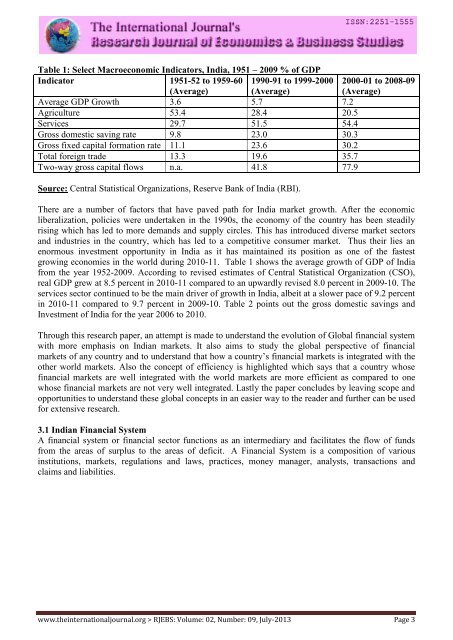Research Journal of Economics & Business Studies - RJEBS - The ...
Research Journal of Economics & Business Studies - RJEBS - The ...
Research Journal of Economics & Business Studies - RJEBS - The ...
You also want an ePaper? Increase the reach of your titles
YUMPU automatically turns print PDFs into web optimized ePapers that Google loves.
Table 1: Select Macroeconomic Indicators, India, 1951 – 2009 % <strong>of</strong> GDP<br />
Indicator 1951-52 to 1959-60<br />
(Average)<br />
1990-91 to 1999-2000<br />
(Average)<br />
2000-01 to 2008-09<br />
(Average)<br />
Average GDP Growth 3.6 5.7 7.2<br />
Agriculture 53.4 28.4 20.5<br />
Services 29.7 51.5 54.4<br />
Gross domestic saving rate 9.8 23.0 30.3<br />
Gross fixed capital formation rate 11.1 23.6 30.2<br />
Total foreign trade 13.3 19.6 35.7<br />
Two-way gross capital flows n.a. 41.8 77.9<br />
Source: Central Statistical Organizations, Reserve Bank <strong>of</strong> India (RBI).<br />
<strong>The</strong>re are a number <strong>of</strong> factors that have paved path for India market growth. After the economic<br />
liberalization, policies were undertaken in the 1990s, the economy <strong>of</strong> the country has been steadily<br />
rising which has led to more demands and supply circles. This has introduced diverse market sectors<br />
and industries in the country, which has led to a competitive consumer market. Thus their lies an<br />
enormous investment opportunity in India as it has maintained its position as one <strong>of</strong> the fastest<br />
growing economies in the world during 2010-11. Table 1 shows the average growth <strong>of</strong> GDP <strong>of</strong> India<br />
from the year 1952-2009. According to revised estimates <strong>of</strong> Central Statistical Organization (CSO),<br />
real GDP grew at 8.5 percent in 2010-11 compared to an upwardly revised 8.0 percent in 2009-10. <strong>The</strong><br />
services sector continued to be the main driver <strong>of</strong> growth in India, albeit at a slower pace <strong>of</strong> 9.2 percent<br />
in 2010-11 compared to 9.7 percent in 2009-10. Table 2 points out the gross domestic savings and<br />
Investment <strong>of</strong> India for the year 2006 to 2010.<br />
Through this research paper, an attempt is made to understand the evolution <strong>of</strong> Global financial system<br />
with more emphasis on Indian markets. It also aims to study the global perspective <strong>of</strong> financial<br />
markets <strong>of</strong> any country and to understand that how a country’s financial markets is integrated with the<br />
other world markets. Also the concept <strong>of</strong> efficiency is highlighted which says that a country whose<br />
financial markets are well integrated with the world markets are more efficient as compared to one<br />
whose financial markets are not very well integrated. Lastly the paper concludes by leaving scope and<br />
opportunities to understand these global concepts in an easier way to the reader and further can be used<br />
for extensive research.<br />
3.1 Indian Financial System<br />
A financial system or financial sector functions as an intermediary and facilitates the flow <strong>of</strong> funds<br />
from the areas <strong>of</strong> surplus to the areas <strong>of</strong> deficit. A Financial System is a composition <strong>of</strong> various<br />
institutions, markets, regulations and laws, practices, money manager, analysts, transactions and<br />
claims and liabilities.<br />
www.theinternationaljournal.org > <strong>RJEBS</strong>: Volume: 02, Number: 09, July-2013 Page 3
















